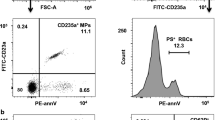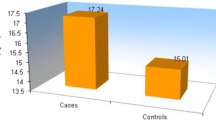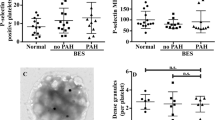Abstract
Non-transfusion-dependent thalassaemia (NTDT) is associated with a hypercoagulable state with thrombotic risk highest after splenectomy. Various mechanisms have been proposed. Although an antiplatelet agent is commonly recommended as thromboprophylaxis in NTDT, the role of platelets contributing to this hypercoagulable state is not well-defined. This study aims to evaluate the role of platelets contributing to hypercoagulability in NTDT patients using thrombin generation (TG). Platelet-rich (PRP) and platelet-poor plasma (PPP) were collected from NTDT patients (n = 30) and normal controls (n = 20) for TG measurement and compared. Controls had higher endogenous thrombin potential (ETP) in PPP (1204.97 nM.min vs 911.62 nM.min, p < 0.001) and PRP (1424.23 nM.min vs 983.99 nM.min, p < 0.001) than patients. Patients’ mean normalized ETP ratio [{PRP ETP (patient)/PPP ETP (patient)}/{mean PPP ETP (controls)/mean PPP ETP (controls)}], demonstrated that the presence of platelet does not alter ETP (mean ratio 0.97, 95% CI 0.93–1.02, equivalence defined as 10%). Types of thalassaemia, splenectomy, and severity of liver iron overload did not significantly influence patients’ ETP in PPP and PRP by multivariate analysis. Platelets did not increase the TG potential of NTDT patients. Instead of being hypercoagulable, our NTDT patients were hypocoagulable by ETP measurement, although this could not be conclusively demonstrated to correlate with their iron overloading state giving rise to reduced synthesis of coagulation factors. The guideline recommendations for thromboprophylaxis with antiplatelet agents in similar NTDT patients should be re-examined.


Similar content being viewed by others
References
Al-Allawi NAS, Jalal SD, Mohammad AM et al (2014) β-thalassemia intermedia in Northern Iraq: a single center experience. Biomed Res Int 2014:262853
Taher A, Isma’eel H, Mehio G, Bignamini D, Kattamis A, Rachmilewitz E, Cappellini M (2006) Prevalence of thromboembolic events among 8,860 patients with thalassaemia major and intermedia in the Mediterranean area and Iran. Thromb Haemost 96:488–491
Musallam KM, Taher AT (2011) Thrombosis in thalassemia: why are we so concerned? Hemoglobin 35:503–510
Cappellini MD, Robbiolo L, Bottasso BM, Coppola R, Fiorelli G, Mannucci PM (2000) Venous thromboembolism and hypercoagulability in splenectomized patients with thalassaemia intermedia. Br J Haematol 111:467–473
Borgna Pignatti C, Carnelli V, Caruso V, Dore F, de Mattia D, di Palma A, di Gregorio F, Romeo MA, Longhi R, Mangiagli A, Melevendi C, Pizzarelli G, Musumeci S (1998) Thromboembolic events in beta thalassemia major: an Italian multicenter study. Acta Haematol 99:76–79
Taher A, Vichinsky E, Musallam K et al (2013) Guidelines for the management of non transfusion dependent thalassaemia (NTDT)
Tripodi A, Cappellini MD, Chantarangkul V, Padovan L, Fasulo MR, Marcon A, Mannucci PM (2009) Hypercoagulability in splenectomized thalassemic patients detected by whole-blood thromboelastometry, but not by thrombin generation in platelet-poor plasma. Haematologica 94:1520–1527
Tatli Gunes B, Turker M, Gozmen S et al (2014) Procoagulant phospholipid activity, whole blood thromboelastography and thrombin generation assay to detect hypercoagulability in thalassemic children. Blood 124:4896
Chantarangkul V, Clerici M, Bressi C et al (2003) Thrombin generation assessed as endogenous thrombin potential in patients with hyper- or hypo-coagulability. Haematologica 88:547–554
Hemker HC, Al Dieri R, De Smedt E, Béguin S (2006) Thrombin generation, a function test of the haemostatic-thrombotic system. Thromb Haemost 96:553–561
Garbowski MW, Carpenter J-P, Smith G, Roughton M, Alam MH, He T, Pennell DJ, Porter JB (2014) Biopsy-based calibration of T2* magnetic resonance for estimation of liver iron concentration and comparison with R2 Ferriscan. J Cardiovasc Magn Reson 16:40
Taher AT, Otrock ZK, Uthman I, Cappellini MD (2008) Thalassemia and hypercoagulability. Blood Rev 22:283–292
Sirachainan N (2013) Thalassemia and the hypercoagulable state. Thromb Res 132:637–641
Eldor A, Lellouche F, Goldfarb A et al (1991) In vivo platelet activation in beta-thalassemia major reflected by increased platelet-thromboxane urinary metabolites. Blood 77:1749–1753
Eldor A, Rachmilewitz EA (2002) The hypercoagulable state in thalassemia. Blood 99:36–43
Trinchero A, Marchetti M, Giaccherini C et al (2017) Platelet haemostatic properties in β-thalassaemia: the effect of blood transfusion. Blood Transfus 15:413–421
Acknowledgements
The authors are very grateful to all the study participants and Xiao Zhang for her help with the co-ordination of study subjects.
Funding
This study was funded by the Singapore General Hospital Research Grant.
Author information
Authors and Affiliations
Corresponding author
Ethics declarations
Conflict of interest
The authors declare that they have no conflict of interest.
Ethical approval
All procedures performed in this study were in accordance with the ethical standards of our institutional research committee and with the 1964 Helsinki declaration and its later amendments or comparable ethical standards.
Informed consent
Informed consent was obtained from all individual participants included in the study.
Rights and permissions
About this article
Cite this article
Tan, C.W., Wong, W.H., Idros, R. et al. Role of platelets in thrombin generation amongst patients with non-transfusion-dependent thalassaemia. Ann Hematol 98, 861–868 (2019). https://doi.org/10.1007/s00277-018-3579-z
Received:
Accepted:
Published:
Issue Date:
DOI: https://doi.org/10.1007/s00277-018-3579-z




